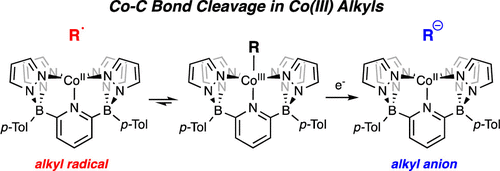当前位置:
X-MOL 学术
›
Organometallics
›
论文详情
Our official English website, www.x-mol.net, welcomes your feedback! (Note: you will need to create a separate account there.)
Synthesis, Characterization, and Reactivity of Neutral Octahedral Alkyl-Cobalt(III) Complexes Bearing a Dianionic Pentadentate Ligand
Organometallics ( IF 2.8 ) Pub Date : 2020-06-09 , DOI: 10.1021/acs.organomet.0c00223 Lucie Nurdin 1 , Warren E. Piers 1 , Jian-Bin Lin 1 , Benjamin S. Gelfand 1
Organometallics ( IF 2.8 ) Pub Date : 2020-06-09 , DOI: 10.1021/acs.organomet.0c00223 Lucie Nurdin 1 , Warren E. Piers 1 , Jian-Bin Lin 1 , Benjamin S. Gelfand 1
Affiliation

|
A variety of neutral alkyl-cobalt(III) complexes bearing a dianionic tetrapodal pentadentate ligand B2Pz4Py are reported. Compounds 2-R (R═CH3, CH2SiMe3, CH2SiMe2Ph, iBu, CH2(c-C5H9), and (CH2)4CH═CH2) are synthesized in 58–90% yield. These diamagnetic, octahedral complexes are thermally stable up to 110°C and are also remarkably stable to ambient atmosphere. They were fully characterized by spectroscopic technique and, in three cases, by X-ray crystallography. Evidence for reversible homolytic cleavage of the Co–C bonds was found in their reactions with the hydrogen atom donor 1,4-cyclohexadiene and the radical-trap TEMPO, as well as the observed cyclization of the 5-hexenyl group to the methylcyclopentyl derivative over the course of several hours. Despite these observations, it can be concluded that the diborate B2Pz4Py ligand provides a very stable platform for these Co(III) alkyls. Reduction by one electron to a Co(II) alkyl can accelerate bond homolysis, but in this instance, using cobaltocene as the reducing agent leads to ejection of an alkide anion through bond heterolysis, an unusual reaction for Co(III) alkyls. Finally, protonation of compound 2-Me with the strong acid HNTf2 leads to divergent reactivity in which the major protonation site is the pyridyl nitrogen of the ligand as opposed to protonation of the methyl group. The product of protonation at nitrogen is the dimeric species 4 which was prepared via separate synthesis and characterized by X-ray crystallography.
中文翻译:

带有双阴离子五齿配体的中性八面体烷基-钴(III)配合物的合成,表征和反应性
报道了多种带有双阴离子四足五齿配体B 2 Pz 4 Py的中性烷基-钴(III)配合物。化合物2-R(R = CH 3,CH 2森达3,CH 2森达2 PH,我卜,CH 2(C ^ -C 5 ħ 9),和(CH 2)4 CH = CH 2)的合成产率为58-90%。这些抗磁性的八面体络合物在高达110°C的温度下具有热稳定性,并且对周围大气也非常稳定。通过光谱技术对它们进行了全面表征,在三种情况下,通过X射线晶体学对其进行了全面表征。Co-C键与氢原子供体1,4-环己二烯和自由基俘获体TEMPO的反应中发现了Co-C键可逆均裂的证据,以及观察到的5-己烯基环化成甲基环戊基衍生物的过程。几个小时的过程。尽管有这些观察结果,但可以得出结论,二硼酸盐B 2 Pz 4Py配体为这些Co(III)烷基提供了非常稳定的平台。一个电子还原为Co(II)烷基可以加速键的均裂,但是在这种情况下,使用钴茂作为还原剂会导致通过键杂解反应排出烷基阴离子,这是Co(III)烷基的不寻常反应。最后,用强酸HNTf 2使化合物2-Me质子化导致发散的反应性,其中主要的质子化位点是配体的吡啶基氮,而不是甲基的质子化。在氮处的质子化产物是二聚体物种4,其通过单独的合成制备并通过X射线晶体学表征。
更新日期:2020-06-23
中文翻译:

带有双阴离子五齿配体的中性八面体烷基-钴(III)配合物的合成,表征和反应性
报道了多种带有双阴离子四足五齿配体B 2 Pz 4 Py的中性烷基-钴(III)配合物。化合物2-R(R = CH 3,CH 2森达3,CH 2森达2 PH,我卜,CH 2(C ^ -C 5 ħ 9),和(CH 2)4 CH = CH 2)的合成产率为58-90%。这些抗磁性的八面体络合物在高达110°C的温度下具有热稳定性,并且对周围大气也非常稳定。通过光谱技术对它们进行了全面表征,在三种情况下,通过X射线晶体学对其进行了全面表征。Co-C键与氢原子供体1,4-环己二烯和自由基俘获体TEMPO的反应中发现了Co-C键可逆均裂的证据,以及观察到的5-己烯基环化成甲基环戊基衍生物的过程。几个小时的过程。尽管有这些观察结果,但可以得出结论,二硼酸盐B 2 Pz 4Py配体为这些Co(III)烷基提供了非常稳定的平台。一个电子还原为Co(II)烷基可以加速键的均裂,但是在这种情况下,使用钴茂作为还原剂会导致通过键杂解反应排出烷基阴离子,这是Co(III)烷基的不寻常反应。最后,用强酸HNTf 2使化合物2-Me质子化导致发散的反应性,其中主要的质子化位点是配体的吡啶基氮,而不是甲基的质子化。在氮处的质子化产物是二聚体物种4,其通过单独的合成制备并通过X射线晶体学表征。


























 京公网安备 11010802027423号
京公网安备 11010802027423号